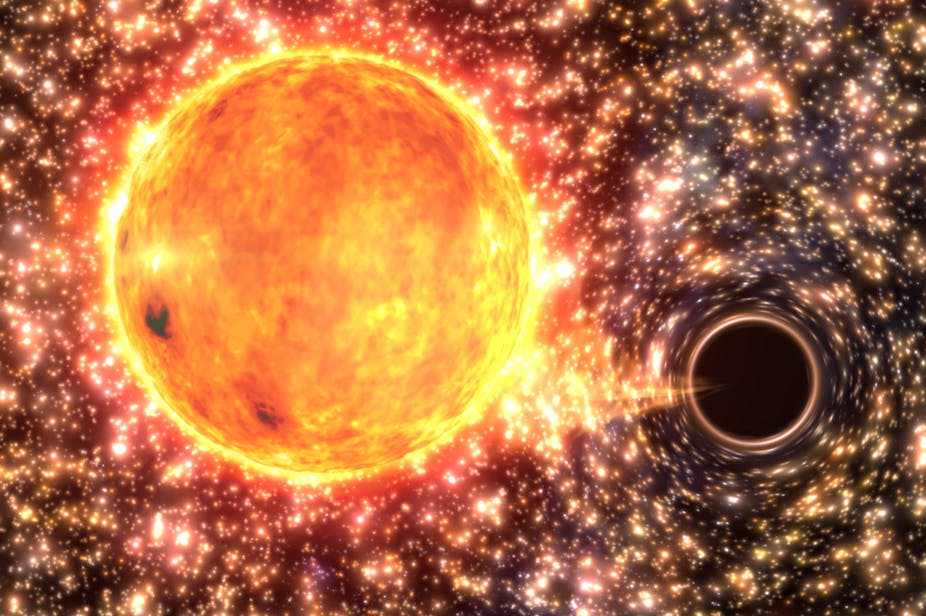Australian researchers have redefined the relationship between galaxies and their black holes, showing that a widely-accepted method for calculating the mass of smaller black holes was wrong.
The breakthrough, made by Swinburne University astronomers using data from telescopes around the world, means that hundreds of scientific papers published on black holes in the last decade were based on wrong assumptions.
“Our understanding of galaxy and black hole co-evolution needs to be significantly revised,” said one of the researchers who made the discovery, Professor Alister Graham from Swinburne’s Centre for Astrophysics and Supercomputing.
His paper on the finding, co-authored by Swinburne researcher Dr Nicholas Scott, will published in The Astrophysical Journal, along with a related work detailing the dense clusters of stars found at the centre’s of lower mass galaxies.
Wrong ratios
Astronomers have thought for the past decade that there was a constant ratio between the mass of the black hole at the centre of a galaxy and the total galaxy mass.
“That ratio was about 0.2%. We thought small galaxies had this same ratio as large galaxies. We have found now, with an increased galaxy sample size, that we all were wrong,” said Professor Graham.
Instead, Professor Graham used data from the Hubble Space Telescope, the European Very Large Telescope in Chile and the Keck Telescope in Hawaii to determine that the black holes in lighter galaxies contain a much smaller fraction of the galaxy’s mass.
Galaxies grow by accreting gas, which they then convert into new stars or feed the central black hole.
“The black holes have been growing much faster relative to the galaxy than we have previously thought and it’s been, to a degree, also at the expense of the star clusters at the centre of these galaxies,” he said.
“If you happen to live on a planet around one of the stars at the centres of these galaxies, that’s not good news because over time the star clusters disappear, possibly devoured,” he said.
“In the big – grown up if you like – galaxies, there are no dense, centrally-located star clusters, just massive black holes containing about 0.5% of the galaxy mass.”
Intermediate black holes
Until now, astronomers have been able to identify very small black holes that have less than 100 times the mass of our Sun, as well as ‘supermassive’ black holes that contain more than 1 million times the mass of our Sun.
Professor Graham and Dr Scott’s research has now uncovered evidence of middle-sized black holes.
“This population has been missing – black holes with masses larger than that of stars but less than that of what we called the supermassive black holes – and a lot of effort has gone into trying to find them,” he said.
“We now know where we think they are. In our paper we have a list of about 50 galaxies which we think house these intermediate black holes.”
Professor Graham said that he realised it would not be easy for many astronomers to accept that their previous assumptions about black holes were wrong.
“But history has shown us that you know you’ve made an important discovery if you meet a lot of resistance,” he said.
Dr Sean Farrell, ARC Postdoctoral Fellow at the University of Sydney’s Institute for Astronomy said Professor Graham’s findings had important implications for astronomy.
“If correct, this essentially means that a lot of the black holes out there that we thought were millions of times the mass of our Sun are actually quite a bit lighter, which could explain the apparent gap between stellar mass black holes (that are a few to tens of times the mass of our Sun) and the supermassive black holes found in large galaxies (that are millions to billions of times more massive), uncovering a population of "intermediate mass” black holes,“ he said.
The discovery that there may not be a constant ratio between the mass of the black hole at the centre of the galaxy and the total galaxy mass of 0.2% means that "many of the black holes whose masses have been estimated using these techniques are potentially lower in mass than originally thought.”
“This has important connotations for our models of how the nuclear black holes in galaxies grew over the age of the Universe. One of the big questions in modern day astrophysics is how did supermassive black holes form and grow? We know that galaxies themselves grow by swallowing clouds of gas, and that they also grow by crashing into other galaxies,” said Dr Farrell.
“For some time now its been thought that the galaxy and black hole masses grew at the same rate, but one of the consequences of this work is that this may not be the case. Instead, it indicates that the black holes in low mass galaxies grew faster than the ones in higher mass galaxies.”

